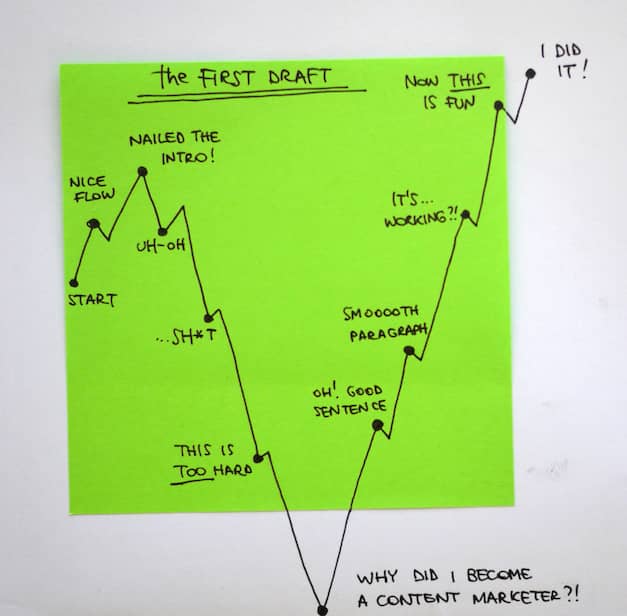
Welcome to contentfolks—a fortnightly newsletter with short lessons & ideas about content that makes a difference, sparks action, and truly serves its audience. Thank you for being here!
Hey 👋
Today is the third in a four-part series that explores the hidden work of publishing a blog post. We look at writing the first draft, which full disclosure I have a love-hate relationship with—where 78% is… not love 🙃

A quick recap of what we’ve covered so far:
- Part 1 looked at the research process required to build a content brief that covers a piece’s ideal audience, its main angle, and the goals for creating it
- Part 2 looked at the importance of an outline in building foundations for a piece and signposting how the argument will unfold
Your first draft ≠ your final piece
If you’re one of those mythical creatures who can sit down, do one perfect draft, thoroughly enjoy the process, and just be done: I salute you.
For most of us, the first draft is miles away from the published piece, and the process looks more like ugly first draft → self-editing → passable second draft → more self-editing → solid third draft → editorial review → final tweaks.
In my experience, there’s no one-size-fits-all advice when it comes to writing the first draft—so let me show you some things that work for me and explain why I recommend them.
💡A practical example 💡
Back to the blog post I’ve been using as an example throughout this series: a piece about content calendars for Ahrefs that will be published next week.
Here are 5 things that helped me write the first draft:
- Starting from the audience
- Defining the topic
- Embracing the ugliness
- Reaching out for expert advice
- Using a product-led approach
1. Starting from the audience
Before any writing happens, I recommend reviewing the content brief and focusing on the audience. This helps you clarify and decide:
- Which tone to use
- Which level of expertise to pitch your content at
- How to address pain points and offer solutions
In the brief, I collected the following information about this blog post’s audience:
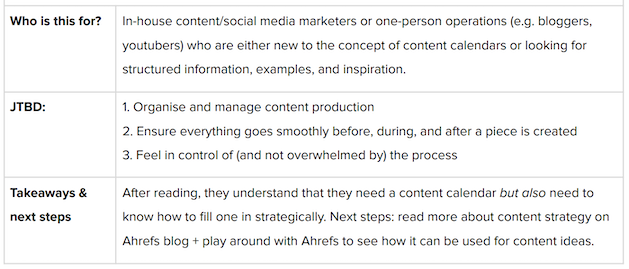
Which meant my first draft would need to:
- Use a confident, helpful tone
- Avoid leaving things unsaid or implied
- Focus on actionable advice
- Offer multiple examples
2. Defining the topic
I like to start my first drafts with a dictionary-like definition of the main topic, which helps me organise and clarify my thoughts.
For this blog post, at first I couldn’t come up with anything better than “a content calendar is a calendar,” because… what else is it?! So I looked for an actual dictionary entry:
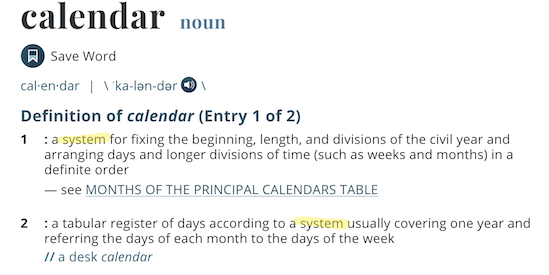
The word ‘system’ made sense, and after some tinkering, I settled on this definition:

Wordy, clunky, and far from perfect—but it did its job: it helped me realise I’d need to cover content calendars from more angles (macro and micro) than I had originally planned.
3. Embracing the ugliness
The first draft is mainly about getting the bulk of your thoughts and ideas on the page, in whichever shape they come. Clumsy paragraphs, awkward phrases, weird gaps: everything’s allowed. It will all get fixed later.
Ann Handley names this stage ‘The Ugly First Draft’, which I always thought was appropriate:
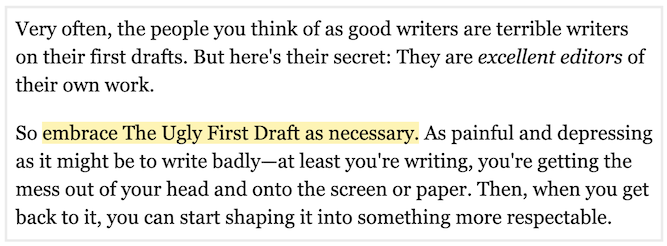
As part of my commitment to The Ugly First Draft, I leave myself yellow placeholders whenever I can’t think of the best way to express something, like I did here:

If I already know a paragraph will be easy (for example, if it’s based on direct experience and requires no extra research), I may use a bla bla bla line and focus on trickier parts first:

And sometimes, when I just keep hitting a wall, I’ll add a temporary XYZ string and move on:

This small workaround is helpful when you get stuck: instead of trying to fix the sentence there and then, you give yourself a visual reminder to come back to it later.
4. Leveraging people’s expertise
One way to truly serve your audience is by making sure they don’t have to google anything or ask themselves “Okay, but what does this actually look like?” as they read your work.
In my case, being thorough about calendars required finding and adding examples from different companies at various levels of content maturity—and for that, I needed some outreach.
I kept things small and personal by reaching out to a few folks I knew (and a few I didn’t, to avoid bias) in the Superpath Slack group. Using a customised message, I asked if they would be willing to share their expertise:

I then had follow-up conversations to learn more about how each person uses their calendar. Eventually, I got six solid examples + screenshots. Success!
Of course, it didn’t all happen on day one → I reached out the week before I started writing, and still had to leave several giant placeholders in the draft while waiting for people to get back to me.
5. Using a product-led approach
Very often, a reader has to get to the bottom of a blog post before learning that the company behind the writing also has a product/service/solution that can help. Instead, I prefer to take a product-led approach and find ways to weave the product into the narrative from the start, actively using it to illustrate a point I’m making.
Here, I introduced a 1st-person account of how the Ahrefs team uses their own product to run research and build a content strategy; this allowed me to showcase the tool in action as an integral part of the story, making sure it would fit naturally without coming across as sales-y, pushy, or disingenuous:
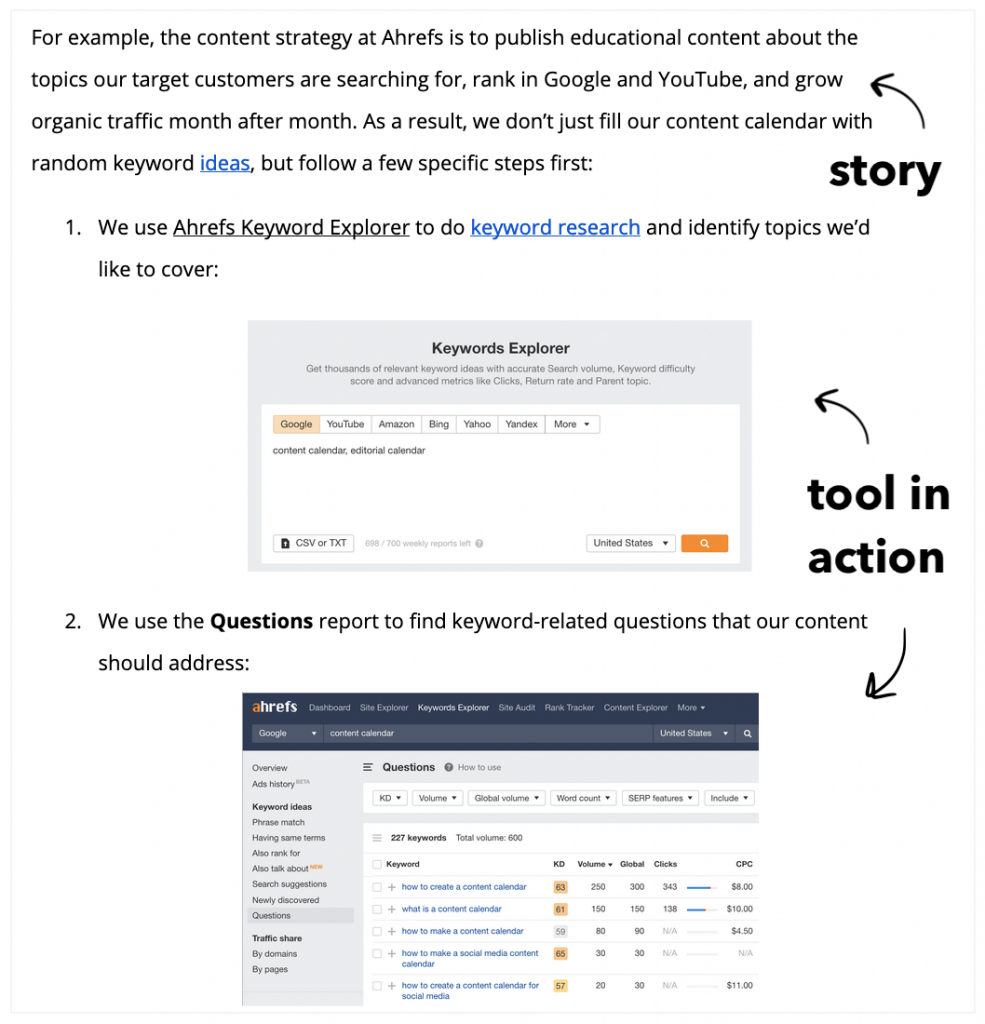
Product-led content is an under-utilised approach that can give you a serious competitive advantage: you’re presenting your product or service as the standard solution from the very start. It’s also one of my favourite things to do 😉
After ~7 hours, I had a semi-decent first draft I was happy-ish with. Yes, there were huge gaps and some serious bad writing, plus a third of my words would need cutting—but I’d done it nonetheless (phew)! I was also VERY EXCITED to close my browser, do literally anything else, and leave the whole thing untouched for the rest of the day.
Does anyone *really* enjoy this part of content creation?
I certainly don’t 😉
Only one more step to go in this journey: editing the first draft into a publishable piece—which is where all the fun is!
See you on May 12 for the grand finale,
